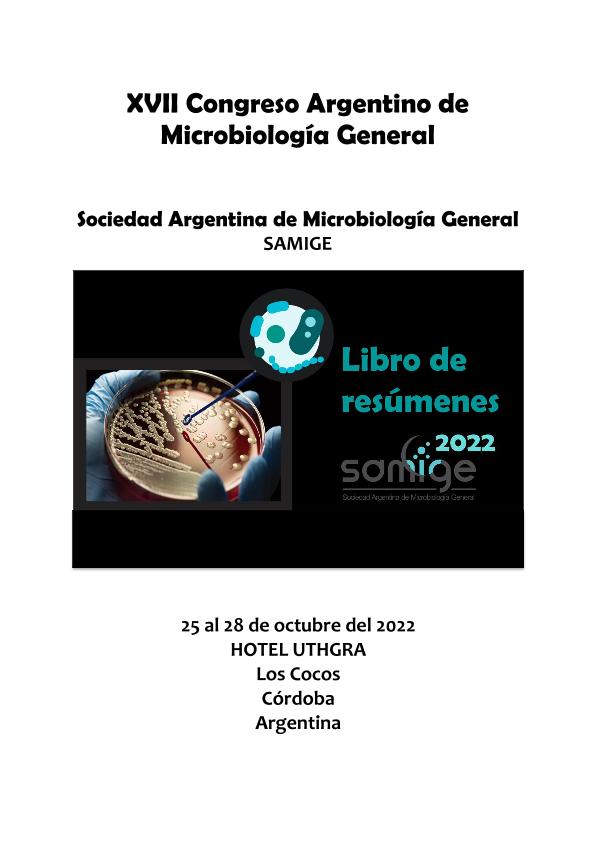Evento
Dibenzothiophene removal and effect on physiological properties of polycyclic aromatic compounds- removing bacteria
Lobo, Constanza Belén ; Correa Deza, Maria Alejandra
; Correa Deza, Maria Alejandra ; Arnau, Victor Gonzalo
; Arnau, Victor Gonzalo ; Ferrero, Marcela Alejandra
; Ferrero, Marcela Alejandra ; Juárez Tomás, María Silvina
; Juárez Tomás, María Silvina
 ; Correa Deza, Maria Alejandra
; Correa Deza, Maria Alejandra ; Arnau, Victor Gonzalo
; Arnau, Victor Gonzalo ; Ferrero, Marcela Alejandra
; Ferrero, Marcela Alejandra ; Juárez Tomás, María Silvina
; Juárez Tomás, María Silvina
Tipo del evento:
Congreso
Nombre del evento:
XVII Congreso Argentino de Microbiología General
Fecha del evento:
25/10/2022
Institución Organizadora:
Sociedad Argentina de Microbiología General;
Título del Libro:
Libro de resúmenes del XVII Congreso Argentino de Microbiología General
Editorial:
Sociedad Argentina de Microbiología General
Idioma:
Inglés
Clasificación temática:
Resumen
Polycyclic aromatic sulfur heterocycles (PASHs) are within a priority pollutant group recognized by the Environmental Protection Agency (EPA). Among PASHs compounds, approximately 70% is represented by dibenzothiophene (DBT), whose contact, ingestion or inhalation has proven to be harmful to human health. Furthermore, DBT is resistant to biodegradation in the environment due to the presence of sulphur atoms. Several bacterial species capable of degrading DBT have been reported in the literature. In order to overcome and persist in polluted environments, microorganisms have developed specialized physiological properties, such as changes in cell surface hydrophobicity (CSH), auto-aggregation (AA) ability, biofilm formation and bioemulsifying activity (EI-24). The aim of this study was to evaluate the physiological properties after DBT exposure of six polycyclic aromatic compounds-removing bacteria as well as their DBT-removing capabilities. The strains were cultured in JPP broth (stationary phase of growth, 30°C, 180 rpm, control medium) and JPP broth with 0.2 mM of DBT (JPP-DBT, 7 days, 30°C, 180 rpm). After that, the physiological properties in both media and DBT removal in JPP-DBT were evaluated. Spectrophotometric methods were used to determine CSH, AA and biofilm formation. The non-polar solvent mechanical agitation method was used to evaluate EI-24. DBT analysis was carried out by reverse phase high performance liquid chromatography. The highest CSH percentages after DBT exposure were observed in Bacillus sp. B18, Rhodococcus erythropolis 20 and Rhodococcus jostii 016 (70%, 84% and 64%, respectively). Only in the case of Rhodococcus sp. F27 an increase (1.73 times) in the AA percentage in presence of DBT was observed. Bacillus sp. B18, Pseudomonas sp. P26, and Gordonia sp. H19 were highlighted with the highest EI-24 values (39%, 27% and 24%, respectively) after DBT exposure. Particularly, Pseudomonas sp. P26 stood out for a 35-fold increase in biofilm formation in the presence of DBT together with a high DBT removal capacity (48%). The results obtained demonstrate that the microbial physiological properties evaluated represent valuable tools to optimize the microbial removal process and therefore bioremediation can be an effective alternative for DBT removal.
Archivos asociados
Licencia
Identificadores
Colecciones
Eventos(PROIMI)
Eventos de PLANTA PILOTO DE PROC.IND.MICROBIOLOGICOS (I)
Eventos de PLANTA PILOTO DE PROC.IND.MICROBIOLOGICOS (I)
Citación
Dibenzothiophene removal and effect on physiological properties of polycyclic aromatic compounds- removing bacteria; XVII Congreso Argentino de Microbiología General; Los Cocos; Argentina; 2022; 69-70
Compartir



